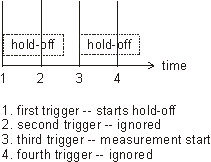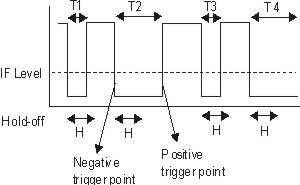Holdoff (Trigger)
Trigger behavior is defined by the Holdoff style selected:
-
Conventional - (default) Trigger specifies the length of time after a trigger before the next trigger can occur. This configures the measurement hardware to ignore trigger signals for a specified period of time. The first trigger event initiates a holdoff; the next trigger event after the holdoff starts the measurement sweep and a new holdoff. This feature is often used in conjunction with trigger to trigger a measurement at the start of a pulse or burst.
In this illustration, the first trigger starts the trigger holdoff. The second trigger is ignored as it occurs during the holdoff. The third trigger starts the next measurement sweep (and a new holdoff).

-
Below Level - Trigger specifies an amount of time that the hardware's input signal must be a stable low value (below the trigger level) before the next trigger can occur.

- Time T1 is less than the holdoff time (H). The hardware does not recognize the signal as being low and there is no trigger.
- Time T2 is longer than the holdoff time (H). After the holdoff time, the hardware triggers at the negative trigger point for a negative slope and the positive trigger point for a positive slope.
- When the trigger input signal goes low again, the holdoff starts. Time T3 is less than the holdoff time (H). The hardware does not recognize the signal as being low and there is no trigger.
- Time T4 is longer than holdoff time (H), so the VSA will trigger on the next negative or positive trigger point depending on the specified slope.
-
Above Level - Trigger specifies an amount of time that the hardware's input signal must be a stable high value (above the trigger level) before the next trigger can occur.

- Time T1 is less than the holdoff time (H). The hardware does not recognize the signal as being high and there is no trigger.
-
Time T2 is longer than the holdoff time (H). After the holdoff time has elapsed, the hardware triggers at the negative trigger point for a negative slope and the positive trigger point for a positive slope.
- When the trigger input signal goes high again, the holdoff starts. Time T3 is less than the holdoff time (H). The hardware does not recognize the signal as being high and there is no trigger.
- Time T4 is longer than holdoff time (H), so the hardware will trigger on the next negative or positive trigger point depending on the specified slope.
The trigger can be entered in seconds, milliseconds, microseconds, or nanoseconds. A negative holdoff cannot be entered.
This trigger parameter is shared by measurements that share the same Analyzer Configuration. Changing this parameter for one shared measurement will change it for the other shared measurements.
Trigger parameters (including this one) affect the outcome of the time record capture from hardware when creating a recording as well as when making a measurement.
Non-causal trigger points
For the above-level/positive slope case or the below-level/negative slope case (i.e. where the edge comes before the holdoff has elapsed), the hardware is configured to capture data that comes before the trigger event. This is accomplished by inserting negative trigger delay equal to the holdoff amount to adjust the capture to start before the trigger event actually happens.
Note that, of course, the hardware cannot send a Trigger Out signal at the positive/negative edge before the holdoff has elapsed, so any other instruments that are using External Triggering to trigger based on this Trigger Out signal need to be configured with negative trigger Delay equal to the amount.
See Also
